Notes
Question by Topic
Notes
This page contains the detailed and easy notes for AQA GCSE Chemistry Quantitative Chemistry for revision and understanding Quantitative Chemistry.
Banner 1AQA GCSE Paper 1: Complete Revision Summary
Quantitative Chemistry
Banner 2Quantitative Chemistry
- a) Calculating Formulas Mass
- b) Calculating Moles from Masses
- c) Calculating Moles from Volume
- d) Calculating Moles from Concentration
- e) Calculations from Balanced Chemical equations
- f) Percentage Yield
- g) Atom Economy
- h) Titrations
RELATIVE FORMUALE MASS
It is the sum of relative atomic mass of all the atoms present in a compound. The ratio of the average mass of one atom compared to 1/12th of the mass of C-12 Eg – CO2 = Mass of C + 2(mass of O) = 12+ (2× 16) = 44g CaCO3 = Mass of Ca + Mass of C + 3(mass of O) = 40+12+ (3× 16) = 100g Ca(PO4)3 = Mass of C + 3 × mass of P+ 12(mass of O) = 310g MOLES – Amount of substance.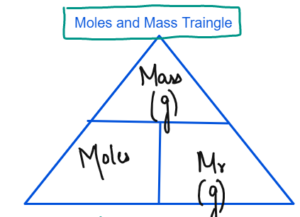


Examples
Q1 Calculate the moles of following- 22g of CO2 Moles = Mass/Mr = 22/44 = 0.5 moles
- 17g of NH3 Mass/Mr = 24/17 =2 moles
- 48dm3 of O2 Volume/24 = 48/24 = 2 moles
- 24000cm3 of CO2 24000/1000dm3 = 24dm3 = 24/24 = 1 mole
- 20g of NaOH dissolved in 50cm3 of Solution Moles = 20/40 = 0.5 moles
- a) 2 moles of calcium carbonate Mass = Moles × Mr =Mr CaCO3 =100 = 2 × 100g= 200g
- b) 0.1 moles of hydrochloric acid Mr of Hcl = 36.5 = 36.5×0.1 = 0.365g
- a) 2 moles of NaOH dissolved in 10 dm3 of solution = Concentration = Moles/V(dm)3 = 2/10 = 0.2 mol dm-3
- b) 20 g of NaOH dissolved in 50 cm3 of solution = Moles of NaOH = 20/40 = 0.5 moles
Avogadros Constant
1 mole = 6.02 x 1023 atoms Q1 Calculate the number of molecules in the following :- 49 g of sulphuric acid
- 8 g of oxygen gas
- 48 dm3 of Nitrogen
- d) 50 cm3 of 0.1 mol dm3 of sodium hydroxide
Loading...
Restricted download
×Balanced Chemical Equations
C + O2 CO2 One mole of carbon is reacting with one mole of oxygen to form one mole of carbon dioxide. 2Al + 3O2 2Al2O3 2 moles aluminium reacts with 3 moles of oxygen to form 2 moles of aluminium oxide. Mg + 2HCl MgCl2 + H2 One mole of magnesium is reacting with 2 moles of hydrochloric acid to form one moles of magnesium chloride and one mole of hydrogen gas. Banner 4CALCULATIONS FROM EQUATIONS
Calculate the mass of Magnesium oxide produced from 6 g of Magnesium when burned complete y in air ? STEP 1: Write the balanced chemical equation. 2Mg + O2 2MgO STEP2: Write known to the left and unknown to the right Mg = MgO STEP3: Write the moles relationship from the balanced chemical equation 2moles = 2 moles STEP4: Convert moles into mass 48g = 80g STEP5: Do the Maths. 48/48 = 1g 80/48 = 1.66g 1g× 6 = 6g 1.66g × 6 = 10g Calculate the mass of alumium needs to produce 306 g of Aluminium Oxide ? STEP 1: Write the balanced chemical equation. 4Al + 3O2 2Al2O3 STEP2: Write known to the left and unknown to the right 2Al2O3 Al STEP3: Write the moles relationship from the balanced chemical equation 2moles = 4 moles STEP4: Convert moles into mass 204g = 108 STEP5: Do the Maths. 306g 108/204 x 306 = 162g Banner 5LIMITING REAGENTS
To work out the limiting reagent work out moles of all the reagents and then work from the balanced chemical equation which reagent is in excess and which is in limiting The reactant that get all used up completely is the limiting reagent. The other reagent which is present in greater quantity than required is in excess. 13.5 gm Aluminium reacts which 32 g of Oxygen- a) Work out the moles of Aluminium and Oxygen
- b) Which reagent is limiting and which is in excess
- c) Calculation the mass of aluminium oxide produced ?
- Moles of Al = 13.5/27 = 0.5 moles
- 4 moles of Alumunium = 3 moles of oxygen
- Al = A2O3
- 2/4
PERCENTAGE YIELD
% yield = observed mass/expected mass x 100 = Actual yield/Theoretical yield x 100 When 28 g of nitrogen combined with hydrogen 30 g of ammonia is made ? Calculate the percentage yield ? N2 + 3H2 2NH3 N2 = NH3 1mole = 2moles of ammonia 28g = 32g of ammonia Expected = 32g Observed = 30g % yield = 30/32 x 100 = 93.75% When 80 g of iron oxide reacts with carbon, 20 g of iron is produced. Calculate the % yield ? 2Fe2O3 + 3C Fe + 3CO2 Fe2O3 = Fe 2 moles = 4 moles 320g = 224 g 1g =224/320 80g = 224/320 x 80 = 56g 20/56 x 100 = 35.71% Banner 7WHY PERCENTAGE YEILD IS NOT 100 %
The percentage yield can never by greater than 100%. It is very difficult to get 100% percentage yield but scientist always look for that route that gives maximum percentage yield.- Reason for not getting 100% yield
- The reaction does not go to completion so complete products are not formed.
- Some of the reaction can start moving to the reverse direction if they are reversible
- Some of the reaction can go and form alterative or unwanted product.
- During the reaction some of the reactants can get lost or stick to the reaction vessel so do not react.
- If the reaction involves gaseous reactants they can escape.
- Some of the products can also get lost in the reaction vessel. If the reaction involves gaseous products they can also escape.
- The reagent might not be pure therefore did not react completely to give the desired yield.
Atom Economy
Atom economy = Mr of desired product/Total Mr of all the Products x 100 Calcium Oxide is produced using the following reaction CaCO3 CaO + CO2 Calculate the atom economy Desired Product = CaO =56g Mass of reactants = CaCO3 = 100g Atom Economy = 56/100 x 100 = 56% Iron oxide is reduced by carbon to form iron and carbon monoxide Fe203 + 3C 2Fe +3CO Calculate the atom economy Desired Product = 2Fe =56 x 2 = 112g Mass of reactants = Mass of Fe2CO3 + 3(Mass of C) = 196g % Yield = 112/196 x 100 = 57%REACTIONS WITH 100 % ATOM ECONOMY
- Addition reaction
- Reactions with only one product have 100 atom economy
- How to increase atom economy?
- Chemist should look for reaction that produce single product
- If the by products are produced they should look for recycling the byproducts or use them in some other reactions to increase the atom economy.
Titration
It is the technique used to determine the exact volume of acid and base to carry out a neutralization reaction.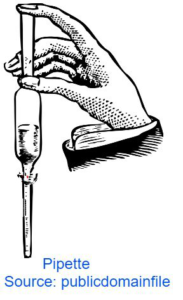

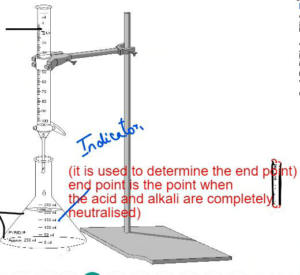

TITRATION PROCEDURE
- Known Concentration solution either acid or base is measured by the pipette and is added into the conical flask. For this solution both concentration and volume is known.
- The indicator is also added in the conical flask. When the indicator changes colour the end point is reached i.e the solution gets completely neutralised.
- The unknown concentration solution is added into the burette. The starting volume is noted from the burette. The tap is then opened and the unknown solution is added dropwise into the conical flask with regular mixing.
- As soon as the indicator changes colour, the tap is closed and the final reading from the burette is noted.
- The entire process is repeated three times and the values are noted in the following format.
- The concordont reading are taken. The anamolous results are not taken into account.
- The means of the concordont readings are noted and used in the calculation
Titration Example
10 cm3 of 0.5 mol dm3 of sulphuric acid is titrated with sodium hydroxide. The results are given in the table. 2NaOH + H2SO4 Na2SO4 + H20 Calculate the concentration of sodium hydroxide required to completely neutralize the acid ? Steps- Write the balanced chemical equation
- Underneath each equation write the numerical value given for each
- The quantity that has two value use the concentration triangle to find the moles
- Use the molar ratio to find the moles of unknown quantity
- Use titration volume and find the concentration
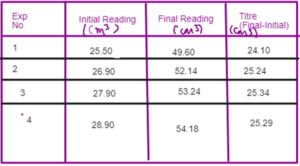 Mean Titre = 25.24+25.34+ 25.29/3
= 25.29cm3
Q1 In a Titration 50 cm3 of 0.1 mol dm3 of potasisum hydroxide is neutralized by 20 cm3 of sulphuric Acid.
Calculate the concentration of sulphuric acid.
Mean Titre = 25.24+25.34+ 25.29/3
= 25.29cm3
Q1 In a Titration 50 cm3 of 0.1 mol dm3 of potasisum hydroxide is neutralized by 20 cm3 of sulphuric Acid.
Calculate the concentration of sulphuric acid.
- a) Write the balanced chemical equation
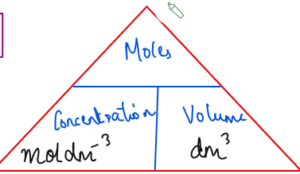
- b) Underneath each equation write the numerical value given for each
- c) The quantity that has two value use the concentration triangle to find the moles
- d) Use the molar ratio to find the moles of unknown quantity
- e) Use titration volume and find the concentration
- Relative atomic mass — It is the ratio of the average mass of an atom compared to one twelfth of the mass of carbon-12
- Relative formula mass — It is the sum of relative atomic masses of all the atoms present in a formulae
- Moles – It is the amount of substance that has the same number of particles found in 12 g of carbon-12.
- Avogadros Constant —Number of particles present in one mole of the substance.
- 1mole = 6.02 x 1023 atoms
- Limiting Reagent – It is the reagent that is completely used up in the reaction
- Yield— The mass of desired product obtained in a chemical reaction
- Percentage yield = Actual yeild /Theoretical Yield x 100
- Atom Economy = Mass of the desired product/total mass of all the reactants x 100
TEST YOURSELF
Q1 Calculate the number of moles in the following- 10 g of calcium carbonate
- 98 g of sulphuric acid
- 18 g glucose
- 90 cm3 of oxygen gas
- 10 cm3 of 0.2 mol dm3 sodium hydroxide solution
Question by Topic
Make sure you have watched the above videos and are familiar with the key definations before trying these questions. It is also good to time yourself while doing these questions so that you can work on the speed as well.
C4-Analytical Chemistry
- Amount of Substance 1 MS
- Amount of Substance 1 QP
- Amount of Substance 2 MS
- Amount of Substance 2 QP
- of Mass, Chemical Measurements & Eqns 1 MS
- of Mass, Chemical Measurements & Eqns 1 QP
- of Mass, Chemical Measurements & Eqns 2 MS
- of Mass, Chemical Measurements & Eqns 2 QP
- of Mass, Chemical Measurements & Eqns 3 MS
- of Mass, Chemical Measurements & Eqns 3 QP
- Using Conc. of Solutions in mol(dm)-3 MS
- Using Conc. of Solutions in mol(dm)-3 QP
- Yield & Atom Economy MS
- Yield & Atom Economy QP
